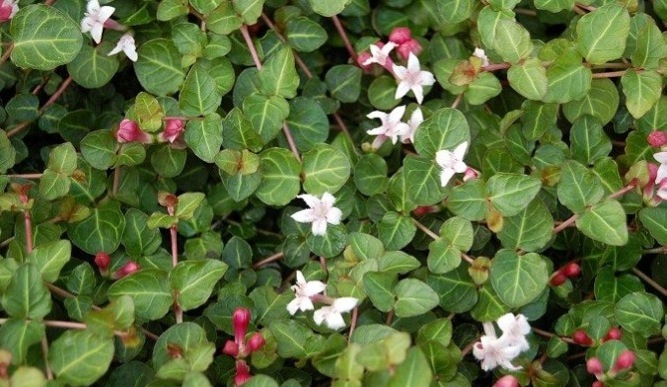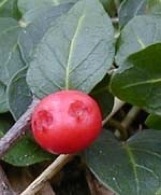Mitchella repens: Madder Berry
The Partridgeberry will not save you from starving but it can make your salad prettier and might keep you alive or ease your pain.
Partridgeberry, Mitchella repens (mit-CHELL-ah REP-enz) has its supporters and detractors, some call it insipid, others call it sour like a cranberry. My friend, forager Dick Deuerling, liked to use them to garnish salads. I found them juicy, if not messy, and very mild in flavor, nearly none. It has up to eight seeds and is nearly impossible to misidentify. There is also a version that grows in Japan. Besides a distinctive leaf, green with a yellow mid-vein, all partridge berries have two dimples because each berry grows from two hairy flowers. Not only does one berry come from two flowers but one flower has a short pistil and long stamens and the other a long pistil and short stamens. They should have called it the Mirror Berry. The plant flowers between April and June and sometimes again in the fall. The berries ripen from July to October and because they are low in fat often persist for several months if not snatched by woodland creatures.
By far the greater calling of the Partridgeberry in North America has been medicinal. A tea from the leaves has a very long and extensive history for easing childbirth and menstrual cramps. That tea is also diuretic, which can lower blood pressure. In the Madder family, the genus Mitchella honors John Mitchell, 1711-1768, a Virginia botanist who actually misidentified the M. repens. Repens means low growing. M. repens is a vine that does not climb. It does make an excellent ground cover. The berry is favored by the ruffed grouse hence the name Partridgeberry. It was also called Squaw Vine for its use by women.
Green Deane’s “Itemizing” plant profile
IDENTIFICATION: A low-growing non-climbing vine often found under leaf litter in deciduous forests. The fruit is a bright red berry, oval, 1/4 to 3/8 inches across, persist through the winter if not eaten. Never abundant. Flower half- inch long, four or five white to faint pink fuzzy petals, appearing mid-summer. Leaves opposite, evergreen, oval to heart-shaped, half inch across, parallel veined, dark green above with a paler yellow-green midrib, pale yellow below.
TIME OF YEAR: Depending upon climate, July to October
ENVIRONMENT: Moist woods, usually among trees that lose their leaves in winter.
METHOD OF PREPARATION: Trail side nibble, salad garnish, sauces, pies and jams. Use like cranberries. Leaves and berries make herbal teas of various applications.




